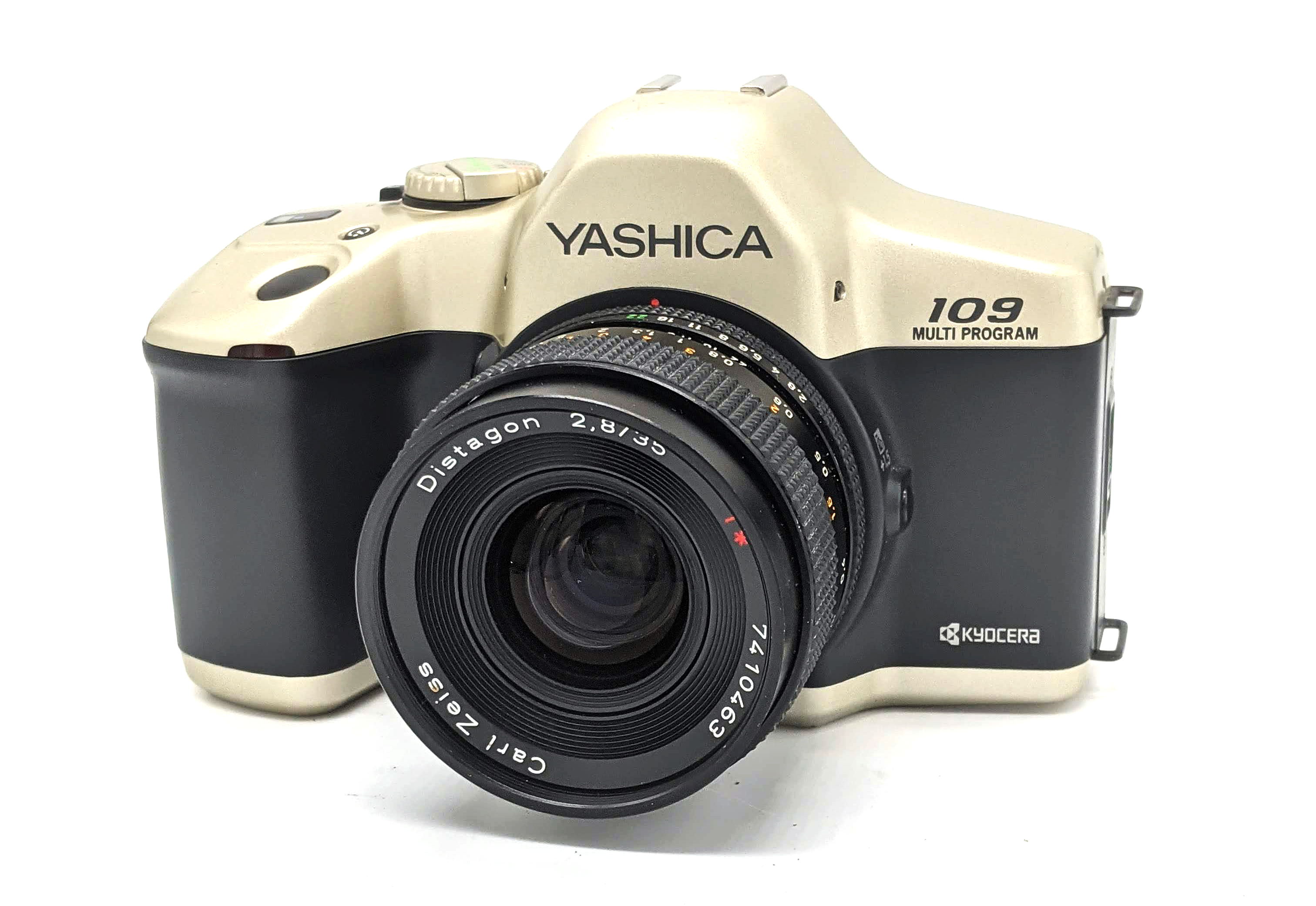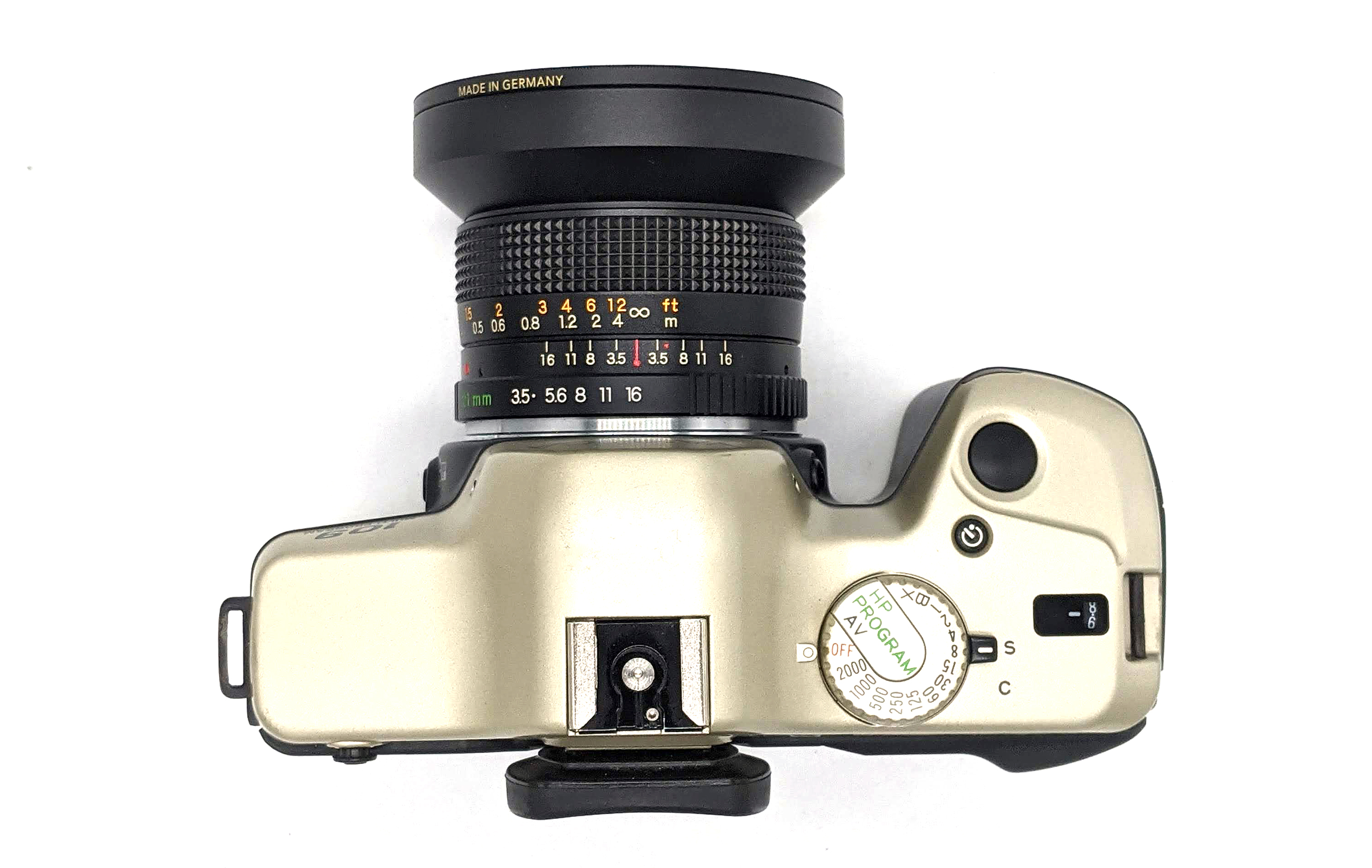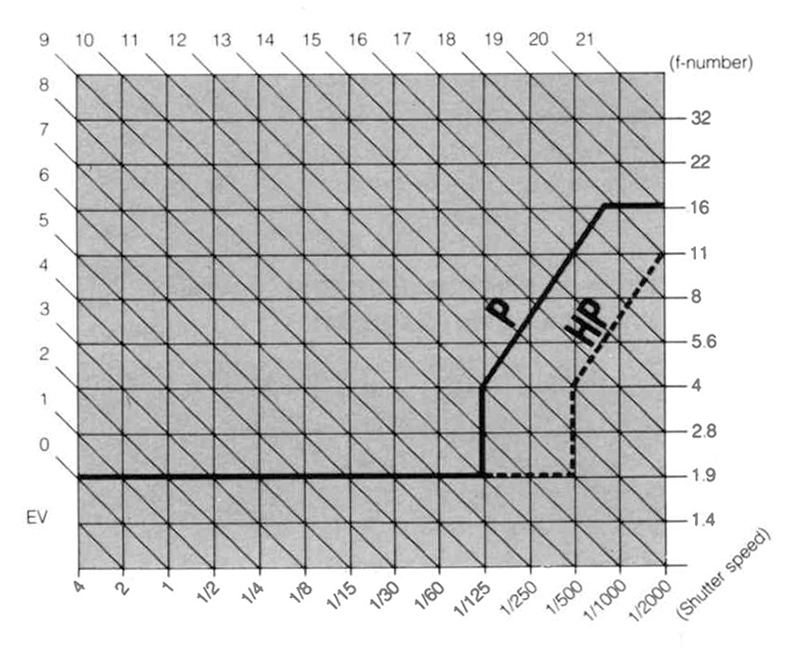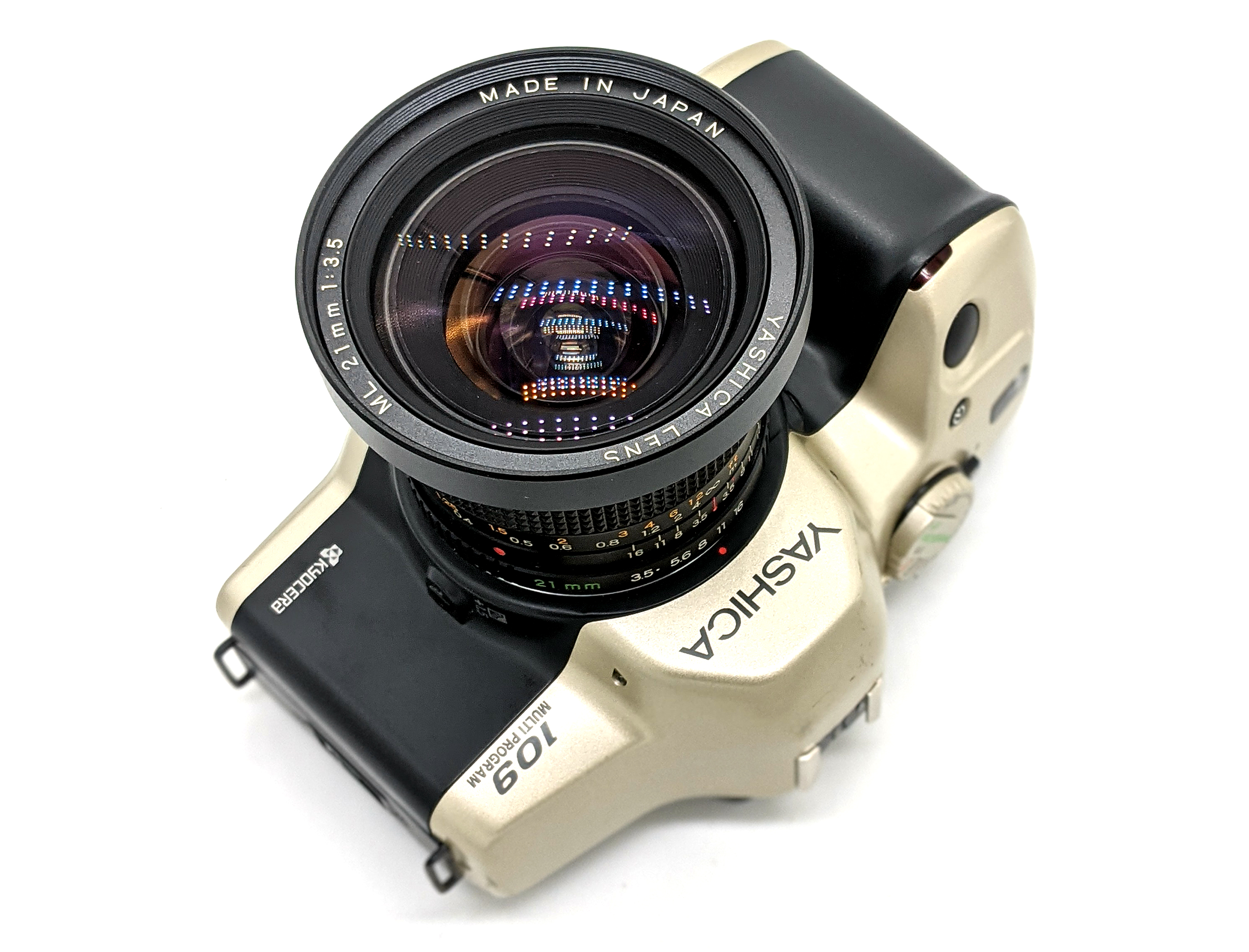
The 1989 109 MP was the last of a line of follow-up cameras to the 1985 FX-103 and Yashica’s final manual-focus 35mm SLR with the Contax/Yashica lens mount. The 107/108/109 series was a hard departure from prior Kyocera Contax and Yashica outings in terms of both design and functionality. Sharing virtually nothing in common with contemporary Contaxes (perhaps some internal components), the 109 was without a doubt the “best” of the 107 series, having a 1/2000 top shutter speed and an auto load/advance/rewind motor drive. It is not a bad camera, but it seems like the answer to a question that no one asked.
Kyocera bought out Yashica in 1983 and continued to produce cameras under both the Contax and Yashica brand names. The first SLRs to come out after the buyout were two electronic-shutter models that introduced “program mode” autoexposure to the lineup: the Contax 159MM and the Yashica FX-103. While the 159MM is undoubtedly a superior product to the FX-103, the cameras were not universes apart. After the 159MM and FX-103, Kyocera would continue to push Contax upmarket and Yashica downmarket.
For 1986, Kyocera unveiled the next two Contax/Yashica products: the 167MT and the FX-3 Super 2000. While the 167MT was the most advanced Contax to date, which an integrated motor drive, multiple metering and exposure modes, advanced flash options, etc., the FX-3 Super 2000 was a minor update to the mechanical-shutter 1984 FX-3 Super, adding a 1/2000 top speed.
While the next Contax-branded product would not appear until 1990 (the professional RTS III), Yashica introduced several new models, including its first autofocus camera, the 200 AF (1987). A year later, Yashica introduced the manual-focus 107 MP. Over the prior FX-103, the 107 MP had an automatic film load and advance, a top shutter speed of 1/2000, and an additional “low-speed” program mode. At the same time, the 107 MP had a lower magnification finder, no detailed exposure information in the viewfinder, no aperture-priority autoexposure mode, and a DX-coded-only film reading system (defaulting to 100 ASA for non-DX canisters). Yashica followed up in 1989 with the 108 MP, which eliminated the “low-speed” program mode in favor of an aperture-priority setting.
The 109 MP would be the best of the series. Over the 108, the 109 would add an auto-rewind feature.The 108s and 109s most often came bundled with a Yashica-branded 35-70mm f/3.5-4.8 zoom. It is not clear how long the 109 MP was produced. It appears that the only Yashica prime lens still being produced into the 1990s was the 50mm f/1.9 ML. Does the 109 have anything to add to the Contax/Yashica universe? Let’s see,
Yashica Models Compared
Here are the FX-103, 107, 108, and 109 compared.
| FX-103 | 107 MP | 108 MP | 109 MP | |
| Year | 1985 | 1988 | 1989 | 1989 |
| Weight | 460g | 500g | 500g | 510g |
| Battery | 2 x SR44 | 4 x AAA | 4 x AAA | 4 x AA |
| Shutter Speeds | B, 11 sec – 1/1000 | B, 16 sec – 1/2000 | B, 16 sec – 1/2000 | B, 16 sec – 1/2000 |
| Viewfinder | 95% / 0.86x | 92% / 0.82x | 92% / 0.82x | 92% / 0.82x |
| Flash Sync | 1/100 | 1/90 | 1/90 | 1/90 |
| Focusing Screen | Microprism / Split | Microprism / Split | Microprism / Split | Microprism / Split |
| ASA Range | 12-3200 | 50-3200 (DX) / 100 ASA Default for non-DX | 25-3200 (DX) / 100 ASA Default for non-DX | 25-3200 (DX) / 100 ASA Default for non-DX |
| Motor Drive? | External (Advance Only) | Advance Only | Advance Only | Advance & Rewind |
| Autoexposure Modes | Program (High & Normal) / Aperture | Program (High / Normal / Low) | Program High / Program / Aperture | Program High / Program / Aperture |
| DOF Preview? | No | No | No | No |
| Settings in VF | Shutter Speed | 3 LEDs (Flash / P / M) | 4 LEDs (Flash / Circle / 2 Arrows) | 4 LEDs (Flash / Circle / 2 Arrows) |
| Exposure Lock? | No | No | No | No |

Operation
The 109 MP is not a complicated machine, but let’s walk through some of its major features.
Size & Weight: Despite its mostly plastic body and class-average weight, the 109 has fairly large physical dimensions.
Exposure Modes: The 109 MP has four exposure modes: program high, program, aperture priority, and metered manual. The camera can use the program modes with every C/Y-mount lens. In both PH and P, simply set the lens to its minimum aperture and shoot away. However, in the P modes, there is no “floor” to how low the shutter speed will go. The camera will set as long a shutter speed as necessary in both P and A modes to take the shot. If you are wondering how the P exposure combinations are calculated, the manual includes the following chart. As you can see the 109 does not have very aggressive programming between “P” and “P High.” You really would want at least a three-stop aperture-stop difference between the two for better background separation. Contax-branded bodies with program modes are more ambitious in this regard.

Metering and Exposure Compensation: The 109 has a single center-weighted metering mode. There is no formal exposure compensation dial or the ability to change the film speed rating. There is also no exposure lock. However, the 109 does include a +1.5 backlight button next to the lens mount. In reality, a +1.5 exposure pull can be used somewhat effectively in real life once one gets the hang of it. It is not just for backlit situations, but also in brightly-lit scenes where shadow detail is sought. It is not a substitute for real exposure compensation or even an exposure lock, but it is better than nothing.
Viewfinder: Unfortunately, the 109 does not display any meaningful exposure information in the viewfinder. There are only four LED lights on the right side of the screen: a flash, a green light, a “down” arrow, and an “up” arrow. However, these four lights provide adequate guidance for any of the exposure modes. In P or A modes, a sole green light will appear if sufficient light exists. If insufficient light exists, the flash LED will blink. It is not clear at what shutter speed the “flash” LED comes on, but my guess is 1/60. In metered manual, the user sets the aperture and shutter speed combinations until the “down” and “up” arrows are both illuminated.
The finder magnification, coverage, and brightness are about average for a camera of this class. The focusing screen has about average brightness. With large-aperture lenses, it is fairly easy to focus. However, with slower zooms, it becomes more difficult. The non-interchangeable focusing screen is the standard microprism collar / split-screen type.
Motor Drive: Unlike the 107 and 108, which could only automatically load and advance the film, the 109’a motor drive can also rewind the film at the end of the roll. Loading the film is straightforward and automatic. The manual does not state the camera’s frames-per-second rate but it appears pretty slow, probably around 1.5 FPS max. The drive is not excessively loud.
DX Coding: Although the 109 can read DX-coded film cassettes from 25 – 3200 ASA, non-DX film will default to 100 ASA with no ability for manual override. This is bad news for those who roll their own film or those who want to push or pull film.
Flash: The 109 has a standard hot shoe and an X-sync port. There is no TTL flash capability. The sync speed of 1/90 is nothing special. With the Yashica-branded CS-140, CS-220, or CS-240 flashes, the camera will automatically set the shutter speed to 1/90 when the flash is attached and on. It is not clear whether any of the contemporary Contax flashes will do the same. With any other auto flash, select the “X” on the shutter speed dial.

Accessories
Besides various Yashica-branded flashes, only two camera body accessories exist.
F-3 Eyecup: The 109 MP takes the standard Contax/Yashica rectangular rubber F-3 Eyecup. These pieces are interchangeable with any Contax or Yashica SLR with the rectangular-style viewfinder piece, like the FX-103, 167MT, and the Aria.
DA-1 Databack: The DA-1 databack’s only capability is the imprinting of the date and year on a negative. The DA-1 worked with both the Yashica autofocus models as well at the 107, 108, and 109. I have never been sure why anyone would want this. The databack reportedly only goes to 2019.
Conclusions
At the end of the day, no C/Y-mount Yashica 35mm film SLR is particularly competitive with a post-RTS II Contax body. However, if one were to consider a Yashica body for the use of C/Y lenses (and you are not a mechanical shutter purist), the FX-103 and 109 remain the most interesting. The 109’s positive aspects are that it has a 1/2000 top speed, can use its P modes with all C/Y lenses, and has a useful motor drive. At the same time, its relatively bulky size, lack of actual exposure information in the viewfinder, lack of exposure compensation or DX override, and lack of exposure lock keep the 109 MP from being a truly competitive manual focus camera. The obvious alternative would be the FX-103, which only has a top shutter speed of 1/1000 and requires an external winder for auto advance. Yet, the FX-103 has exposure override, no DX-coding issue, and shutter speed information in the viewfinder. Combining the best features from the FX-103 and the 109 MP would have resulted in a somewhat competitive product, and easily possible, but alas, never happened.
At the end of the day, if looking for a beginner SLR or a second or third or fourth body for your C/Y lens collection, or just want to try something different, the 109 MP is certainly a capable and seemingly reliable machine. While the prices for all working 35mm film SLRs are rising, the 109 has remained (for now) outside of both the “collector” and “influencer” spheres that are driving the upward spiral.
Appendices
Here is a timeline of Contax and Yashica manual-focus 35mm SLRs.
| Year | Contax | Yashica |
|---|---|---|
| 1975 | RTS | FX-1 |
| 1976 | FR & FX-2 | |
| 1977 | FR I & FR II | |
| 1978 | ||
| 1979 | 139Q | FX-3 & FX-7 |
| 1980 | 139MD | FX-D |
| 1981 | ||
| 1982 | RTS II & 137MA | FX-A |
| 1983 | FX-70 | |
| 1984 | FX-3 Super | |
| 1985 | 159MM | FX-103 |
| 1986 | 167MT | FX-3 Super 2000 |
| 1987 | ||
| 1988 | 107 MP | |
| 1989 | 108 MP & 109 MP | |
| 1990 | RTS III | |
| 1991 | ||
| 1992 | ST & S2 | |
| 1993 | ||
| 1994 | RX & S2b | |
| 1995 | ||
| 1996 | AX | |
| 1997 | ||
| 1998 | Aria |
Here is a list of mechanical-shutter Yashica models compared.
| FX-2 | FX-3/FX-7 | FX-3/FX-7 Super | FX-3 Super 2000 | |
| Year | 1976 | 1979 | 1984 | 1986 |
| Weight | 690g | 446g | 445g | 445g |
| Battery | PX675 | 2 x LR44 | 2 x LR44 | 2 x LR44 |
| Shutter Speeds | B, 1 – 1/1000 | B, 1 – 1/1000 | B, 1 – 1/1000 | B, 1 – 1/2000 |
| Viewfinder | 90% / 0.89x | 92% / 0.90x | 92% / 0.91x | 92% / 0.91x |
| Flash Sync | 1/60 | 1/125 | 1/125 | 1/125 |
| Focusing Screen | Microprism | Microprism / Split | Microprism / Split | Microprism / Split |
| ASA Range | 12-1600 | 12-1600 | 12-1600 | 25-3200 |
| Motor Drive? | No | No | No | No |
| Exposure Modes | Metered Manual | Metered Manual | Metered Manual | Metered Manual |
| DOF Preview? | Yes | No | No | No |
| Settings in VF | + / – Only | 3 x LEDs | 3 x LEDs | 3 x LEDs |
| Exposure Lock? | No | No | No | No |
Here is a list of electronic-shutter Yashica 35mm film SLRs.
| FX-1 | FR | FR I | FR II | FX-D | FX-A | FX-70 | |
| Year | 1975 | 1976 | 1977 | 1977 | 1980 | 1982 | 1983 |
| Weight | 695g | 650g | 660g | 650g | 460g | 470g | 435g |
| Battery | 6V Silver | 6V Silver | 6V Silver | 6V Silver | 2 x S76 | ? | 2 x S76 |
| Shutter Speeds | B, 2 sec – 1/1000 | B, 1 – 1/1000 | B, 4 sec – 1/1000 | B, 4 sec – 1/1000 | B, 1 sec – 1/1000 | B, 11 sec – 1/1000 | B, 11 sec – 1/1000 |
| Viewfinder | ? | 92% / 0.87x | 92% / 0.87x | 92% / 0.87x | 95% / 0.86x | 95% / 0.86x | 95% / 0.86x |
| Flash Sync | 1/60 | 1/60 | 1/60 | 1/60 | 1/100 | 1/100 | 1/100 |
| Focusing Screen | Microprism | Microprism / Split | Microprism / Split | Microprism / Split | Microprism / Split | ? | Microprism / Split |
| ASA Range | 12-3200 | 12-3200 | 12-3200 | 12-3200 | 25-1600 | 25-1600 | 25-1600 |
| Motor Drive? | No | External | External | External | External | ? | No |
| Autoexposure Modes | Aperture | Metered Manual | Aperture | Aperture (Only) | Aperture | Aperture | Aperture (Only) |
| DOF Preview? | Yes | Yes | Yes | No | No | ? | No |
| Settings in VF | Aperture & Shutter Speed | Aperture & Shutter Speed | Aperture & Shutter Speed | Shutter Speed | Shutter Speed | ? | Shutter Speed |
| Exposure Lock? | No | No | Yes | Yes | Yes | ? | Yes |
Thank you very much for this important information about Yashica cameras.